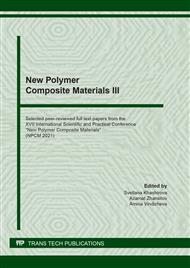[1]
S.I. Dubina, V.G. Kandrashin, The Quality of Russian Highways, Transport of the Russian Federation. 2 (2006) 49-50.
Google Scholar
[2]
M.N. Partl, Advances in Interlaboratory Testing and Evaluation of Bituminous Materials, State-of-the-Art Report of the RILEM, Springer, New York, (2013).
DOI: 10.1007/978-94-007-5104-0_1
Google Scholar
[3]
Yu Huchenreuter, Asfal't v dorozhnom stroitel'stve [Asphalt in road construction] ABV-press, (2013).
Google Scholar
[4]
L.M. Gokhman, Dorozhny Asfal'topolimerbeton [Road Asphalt-polymer Concrete] Econ-Inform, (2017).
Google Scholar
[5]
Polymer Modified Bitumen, Woodhead Publishing, Cambridge, UK, (2011).
Google Scholar
[6]
M. Porto, P. Caputo, V. Loise, et al., Bitumen and Bitumen Modification: A Review on Latest Advances, Appl. Sci. 9 (4) (2019) 742.
DOI: 10.3390/app9040742
Google Scholar
[7]
JS. Chen, CT Lee, YS. Chen, Storage Stability Evaluation of Polymer Modified Bitumens, Journ. of the East. Asia Soc. for Transp. Stud. 12 (2017) 1518-1530.
Google Scholar
[8]
I.V. Gordeeva, D.A. Melnikov, V.N. Gorbatova, D.S. Reznichenko, Yu. A. Naumova, Investigation of modified bitumen binders via Fourier-transform infrared spectroscopy. Fine Chem. Technol. 15(2) (2020) 56-66.
DOI: 10.32362/2410-6593-2020-15-2-56-66
Google Scholar
[9]
D. Lesueur, The Colloidal Structure of Bitumen: Consequences on the Rheology and on the Mechanisms of Bitumen Modification, Advances in Colloid and Interface Science. 145 (2009) 42-82.
DOI: 10.1016/j.cis.2008.08.011
Google Scholar
[10]
H. L. Von Quintus, J. Mallela, M. Buncher, Quantification of Effect of Polymer-Modified Asphalt on Flexible Pavement Performance, Journ. of Transp. Resear. Board. 2001 (2007) 141-154.
DOI: 10.3141/2001-16
Google Scholar
[11]
A. Behnood, M.M. Gharehveran, Morphology, rheology, and physical properties of polymer-modified asphalt binders, Europ. Polym. Journ. 112 (2018) 766-791.
DOI: 10.1016/j.eurpolymj.2018.10.049
Google Scholar
[12]
Sun Daquan, Fen Ye, Fangzhi Shi, & Weimin, Lu. Storage stability of SBS-modified road asphalt: Preparation, morphology, and rheological properties. Petroleum Science and Technology. 24(9) (2007) 1067–1077.
DOI: 10.1081/lft-200048186
Google Scholar
[13]
A. Pérez-Lepe, F.J. Martínez-Boza, C. Gallegos. High temperature stability of different polymer-modified bitumens: a rheological evaluation, J. Appl. Polym. Sci.103 (2) (2007) 1166–1174.
DOI: 10.1002/app.25336
Google Scholar
[14]
Sun, D., and Lu, W. (2003). Investigation and Improvement of storage stability of SBS modified asphalt. Petroleum Science and Technology 21(5&6):901–910.
DOI: 10.1081/lft-120017456
Google Scholar
[15]
GOST R 52056-2003 Polymer-bitumen binders for roads on the basis of block copolymers of styrene-butadiene-styrene type. Specifications. (2007).
Google Scholar


